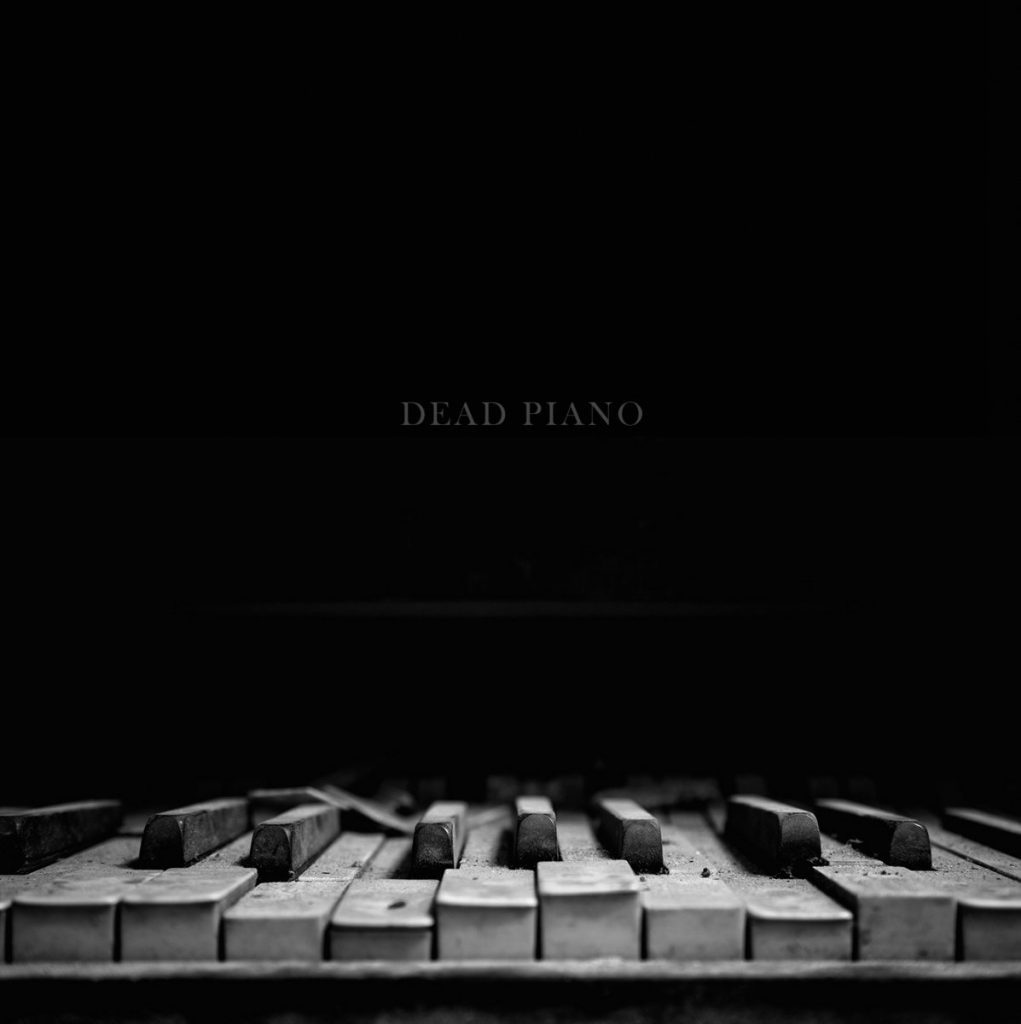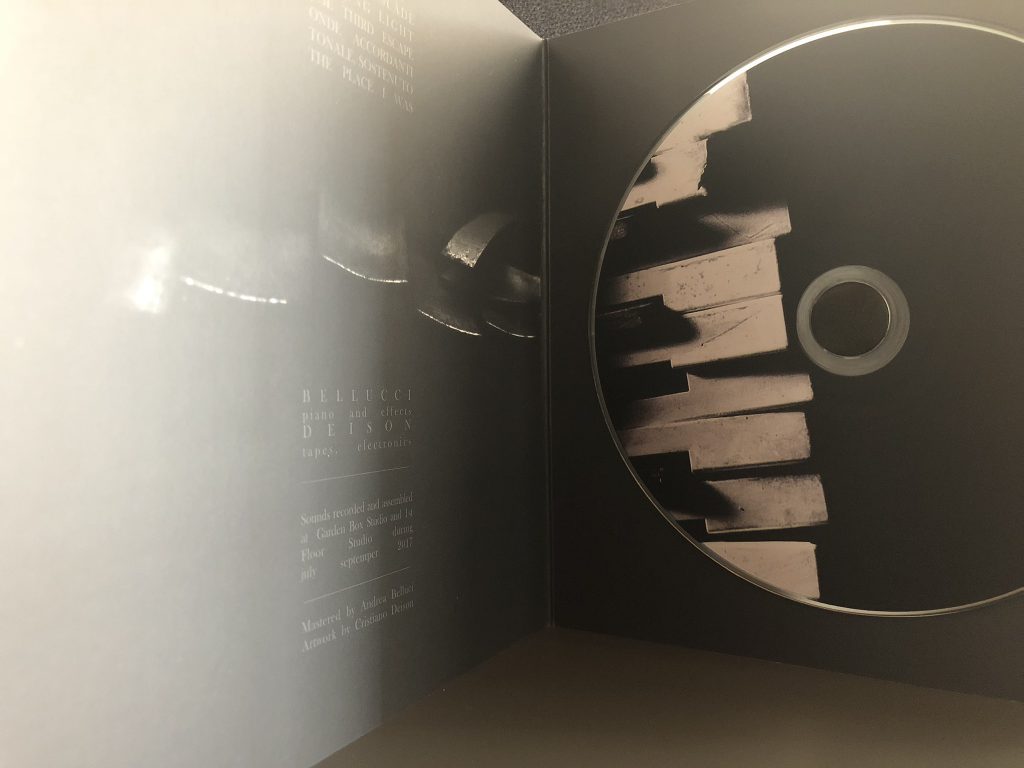DEAD PIANO
(CD, st.an.da., 2018)


01. Linear Cascade
02. Talking Light
03. The Third Escape
04. Onde Accordanti
05. Tonale Sostenuto
06. The Place I was
The idea of “DEAD PIANO” was born from the intention of using the sound of the piano in a different context, compared to what we are used to listen. Can this instrument become a different ‘sound generator’? Beyond what has been done in the past, when many composers used a ‘prepared piano’, where they placed microphones near the strings, or pieces of metal that generated particular sounds resonating with the strings, the most recent technology offers many tools to manipulate that same sound, so well-known and unmistakable, and transform it into something quite different. Therefore it is possible for the piano to become a generator of percussive sounds, pads and drones, creating a sound palette that is reconciled with other sound sources becoming a cohesive and intriguing whole. The piano sounds manipulated by ANDREA BELLUCCI, are perfectly integrated with the atmospheres generated by CRISTIANO DEISON‘s machines, creating ‘sonic landscapes’ which complement each other. Not only melody then, where the piano can be considered ‘the instrument’ par excellence, but also the search for atmospheres and environments that can involve the listener, perhaps giving unexpected emotions.
DEAD PIANO SU KATHODIK
Il piano suonato e digitalmente alterato dallo spezzino Andrea Bellucci (meglio noto come Red Sector A) e i macchinari di Cris Deison ad integrarsi nel progetto collaborativo Dead Piano.
Un percorso lungo una trentina di minuti, dove lo strumento pianoforte, trattato come generatore di suoni, vien trasportato lungo espressive coordinate Eno (l’iniziale Linear Cascade).
Reso sfrigore di bruma in attrito con cielo e terra (Talking Light) tra leggeri scossoni e sbatacchiamenti.
Sublime spaziatura ambient/dronante (The Third Escape) sottoposta a leggere pressioni che ne ammaccano impercettibilmente l’involucro.
Armonie e gocciolamenti di note in caduta da delay, field recordings gentili e digitalismi in sibilo cosmico distesi tutt’attorno come neve (Onde Accordanti).
Fluire, senza necessità di effetti speciali a distoglier l’attenzione, pulviscolo di puntina su vinile in circolo, potrebbe esser pur un fuoco nella sua casa/camino (Tonale Sostenuto / The Place I Was).
Raccoglimento, discrezione, senso delle proporzioni nel dosaggio.
La notte che non tiene più la luce in arrivo e lenta cede il passo.
DEAD PIANO SU ONDAROCK
Cristiano Deison e Andrea Bellucci sono due artisti italiani che non dovrebbero aver bisogno di presentazioni. Ricordiamo soltanto che il primo si muove da più di vent’anni nel campo della musica elettronica, negli anni Novanta come membro dei Meathead e in seguito realizzando una miriade di lavori da solo o in collaborazione con artisti del calibro di Teho Teardo, Maurizio Bianchi, Mingle, Thurston Moore, Scanner ecc. Andrea Bellucci è un altro veterano della scena elettronica italiana, conosciuto principalmente per il suo progetto Red Sector A che, da sonorità di stampo techno, breakbeats e Idm, si è spostato in tempi recenti verso forme più astratte e di carattere ambient. La nuova collaborazione vede i due lavorare attorno ai suoni di un pianoforte da cui ricavano sei composizioni tra drone music e ricerca elettroacustica. Delicati paesaggi sonori, melanconici e intimisti, prendono forme dalle manipolazioni del pianoforte ad opera di Bellucci, mentre le macchine di Deison lavarono sulle sfumature di un’elettronica minimale, sospesa tra silenzio e rumore. È proprio nei dettagli che l’opera si fa apprezzare maggiormente, specie nel cupo finale di “The Place I Was”. Brani come “The Third Escape” e “Onde accordanti” ricordano un po’ le atmosfere acquatiche e mnemoniche di “Tiliaventum”, altra collaborazione di Deison (ma quella volta con Andrea Gastaldello) uscita nel 2017. “Dead Piano” è un lavoro che richiede molto attenzione per cogliere tutte le varie sfumature della ricerca sonora operata dal duo. Alla lunga, può risultare un po’ ripetitivo in certi passaggi e soluzioni. Pregevole ed evocativo l’artwork del cd digipak che esce in edizione limitata per St.An.Da.
DEAD PIANO SU SOWHAT
Decostruire per trovare una dimensione differente che faccia emergere tratti inesplorati di ciò che è più che consolidato. Non un pianoforte che muore, piuttosto uno strumento che attraverso un processo di marcata manipolazione trova nuova linfa proiettandosi verso orizzonti inattesi. È un’intenzione precisa a muovere Andrea Bellucci e Cristiano Deison lungo i solchi di questa loro collaborazione, un’idea chiara che ispira una ricerca volta ad affrancare un suono che rischia di divenire sterile ripetizione. Affidandosi alle pressoché infinite possibilità derivanti dall’applicazione della tecnologia quale mezzo di trasfigurazione e ricomposizione delle armonie acustiche e implementando il risultato con l’ausilio di ulteriori flussi sintetici che ne saturino il fluire sinuoso, i due artisti plasmano un’affascinante esplorazione in sei atti imperniata appunto sull’utilizzo del piano quale generatore di risonanze profondamente atmosferiche. Mantenendone solo in parte il portato melodico e amplificandone il tratto evocativo grazie all’innesto prezioso di flebili modulazioni elettroniche, ciò che viene originato è una vaporosa sequenza di minuti paesaggi emozionali ricchi di dettagli e sfumature. Un notturno evanescente, intriso di sfuggente malinconia, che avvolge e conduce tra le pieghe di un immaginifico universo in cui nulla è ciò che sembra.
DEAD PIANO ON VITAL WEEKLY
It might very well the case that both the project name and the title of this album is Dead Piano, but I kept it to just one name. I am also not sure if this a one-off project or something that will go on for some time, but it is the musical collaboration between Andrea Bellucci on piano and effects and Cristiano Deison on tapes and electronics. The cover is very black and hard to read in this moment of twilight, but the moment is, on the other hand, the perfect time to listen to the music. It is slow and dark music in which the piano this time is not played by just touching the keys but also the strings and the body, the complete usage of the instrument and expand those tones with further addition of electronics. These create a fine set of drones and tones in which all those piano treatments calmly float around. The space in which this piano was located plays only occasionally a role, such as at the beginning of ‘Onde Accordanti’. The melodies played by the piano are rather sparse; the electronic treatment may sound like Brian Eno, but the piano is not always like that of Harold Budd. Belluci’s plays his notes way sparser, a chord here, some delay on it, much reverb and it all works very well. The crackles placed very sparsely add a further element of abstraction. The whole album lasts thirty-two minutes, and after repeated playing I haven’t figured out if I think that’s the right length or that I would have liked some more. A few times I thought ‘nah, this is enough as it clearly indicates what it is and what the concept is’ but sinking back in another chair, picking up a book, followed by ‘hey why did it stop already’, made me think that it could have as easily been fifty minutes. Altogether this is a very consistent record and a true beauty of pastoral music.